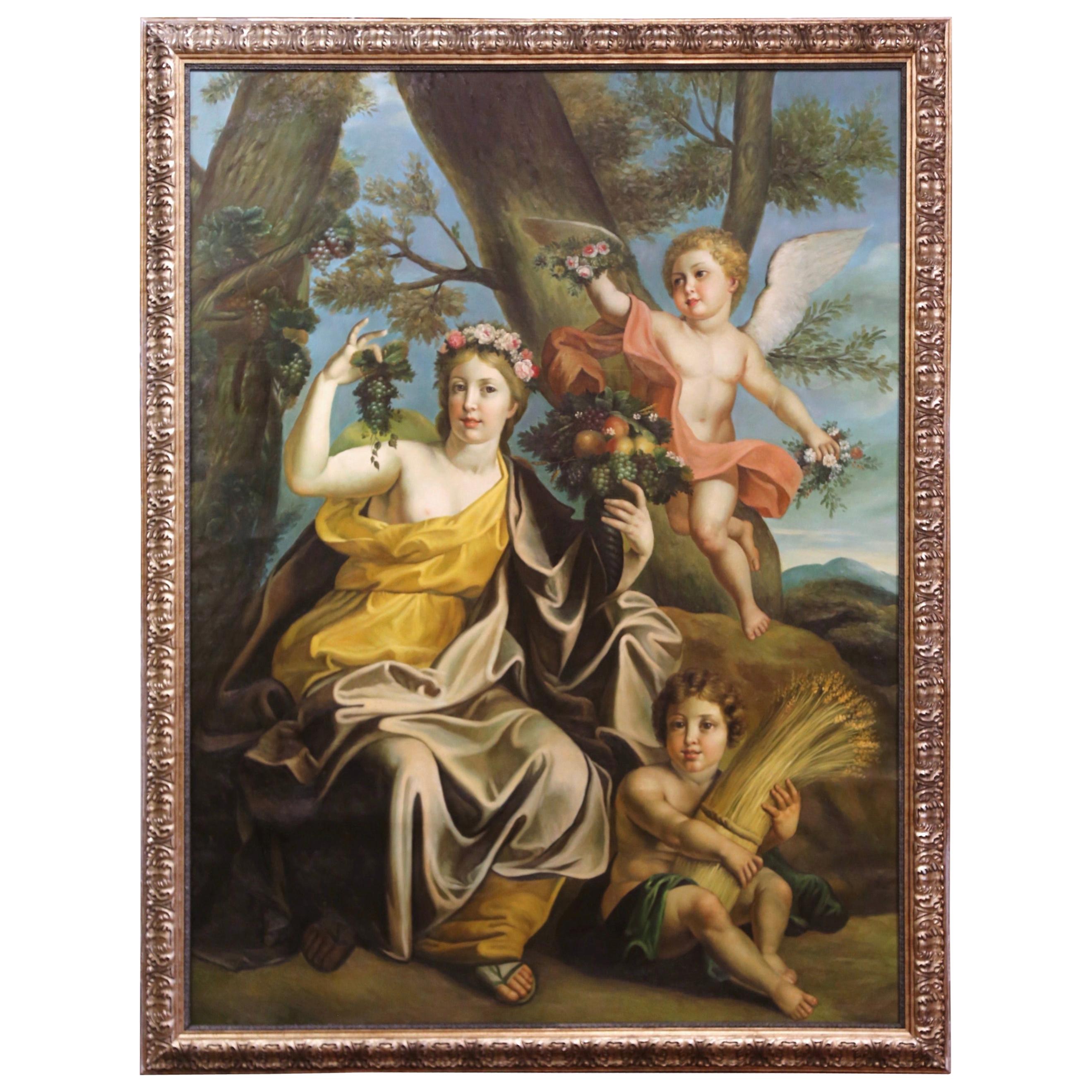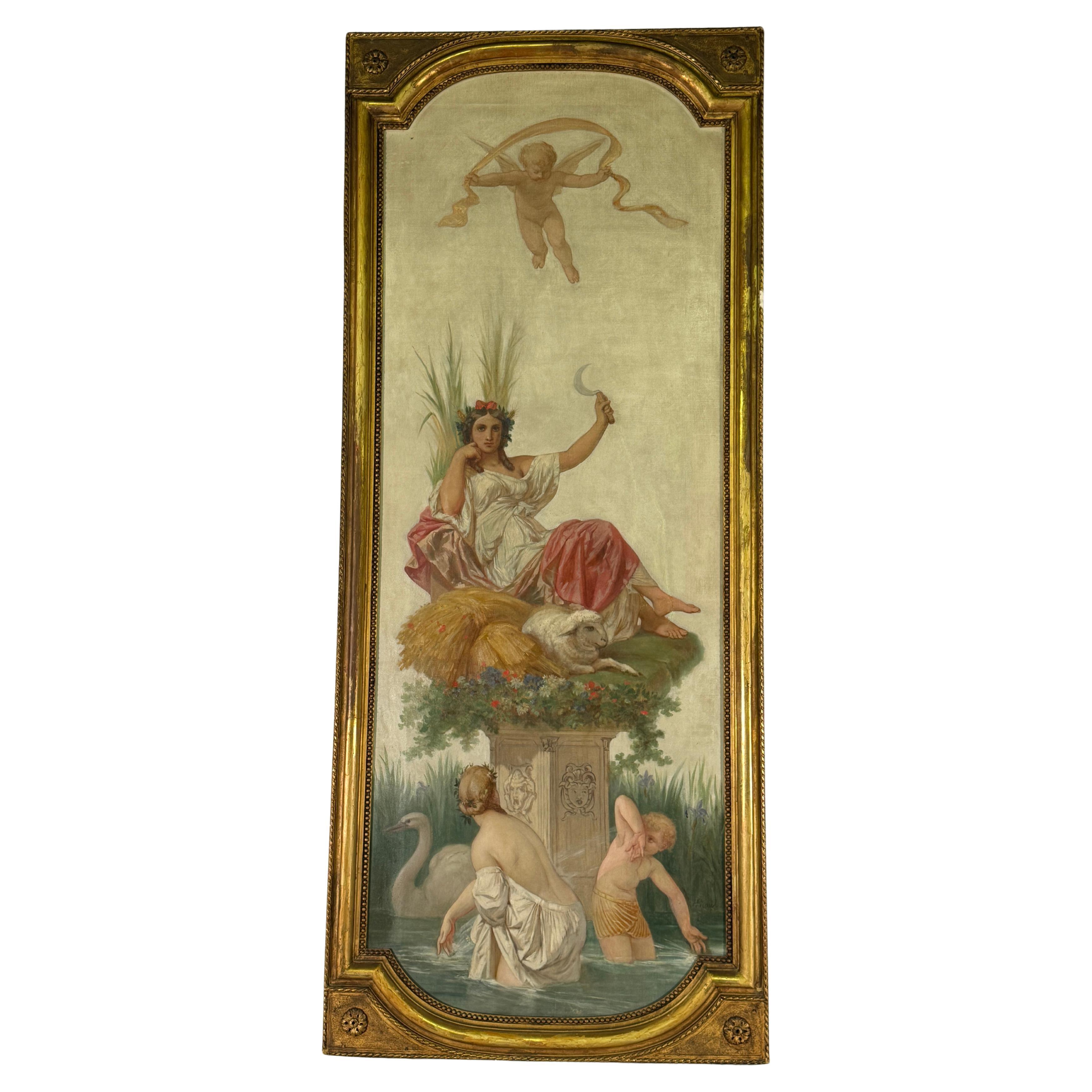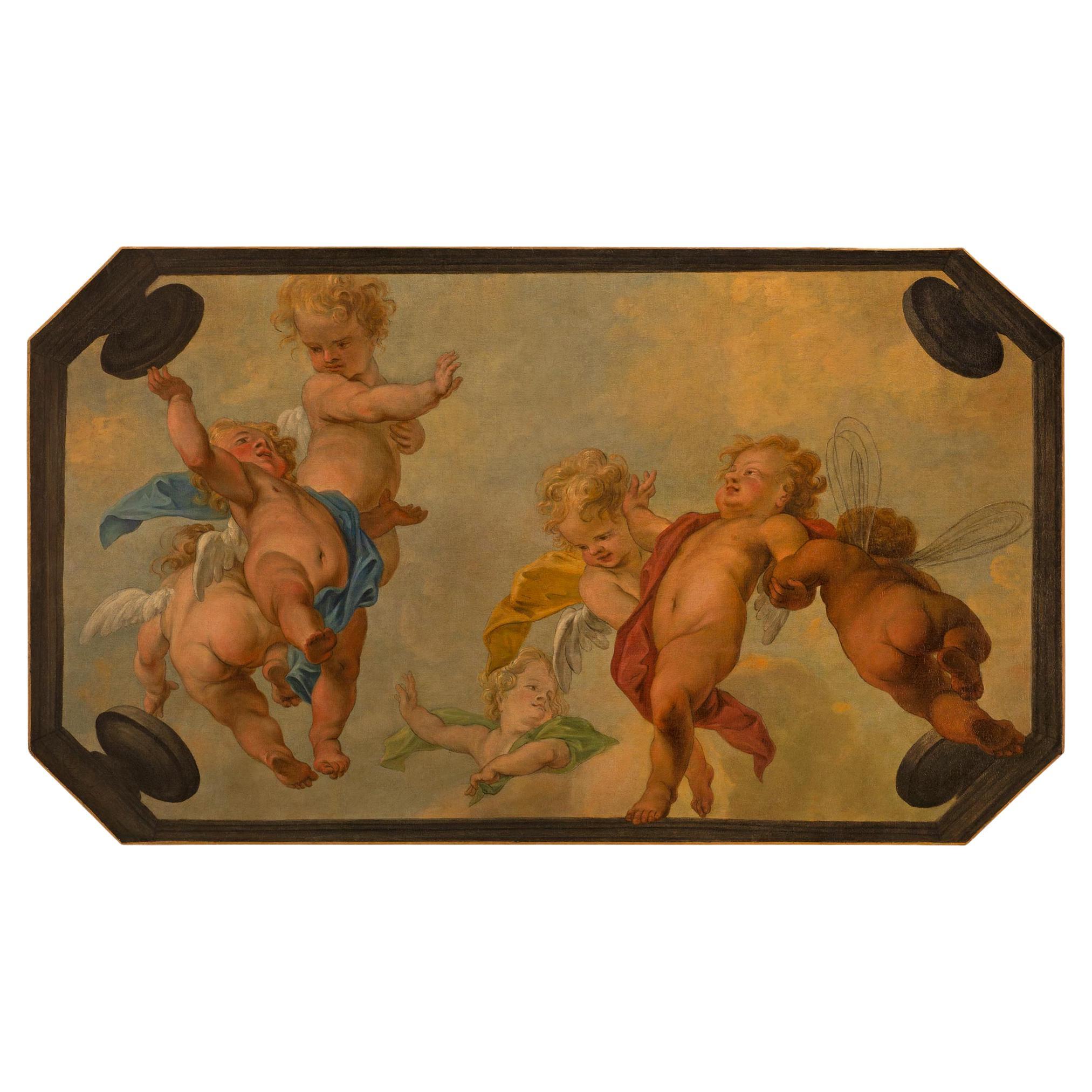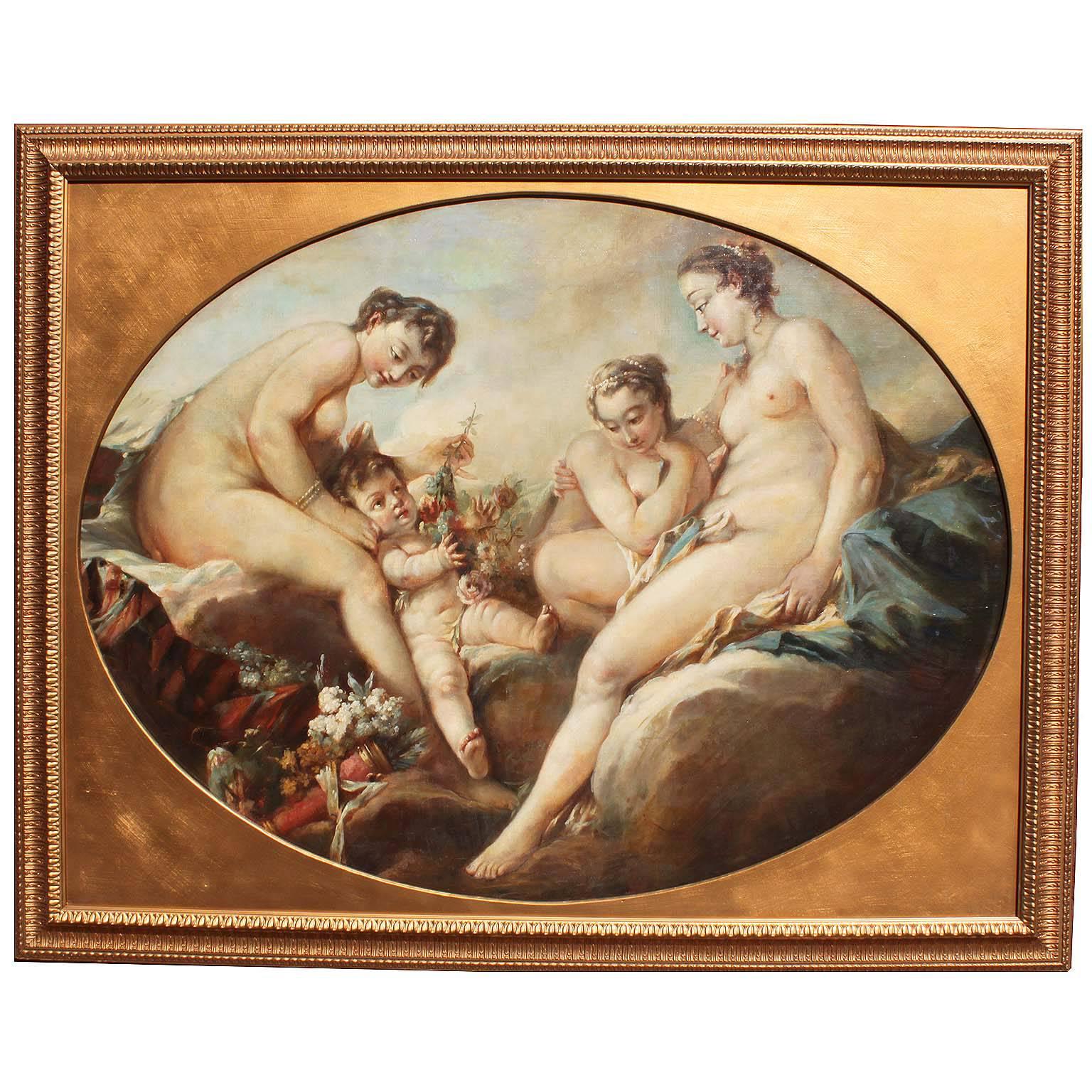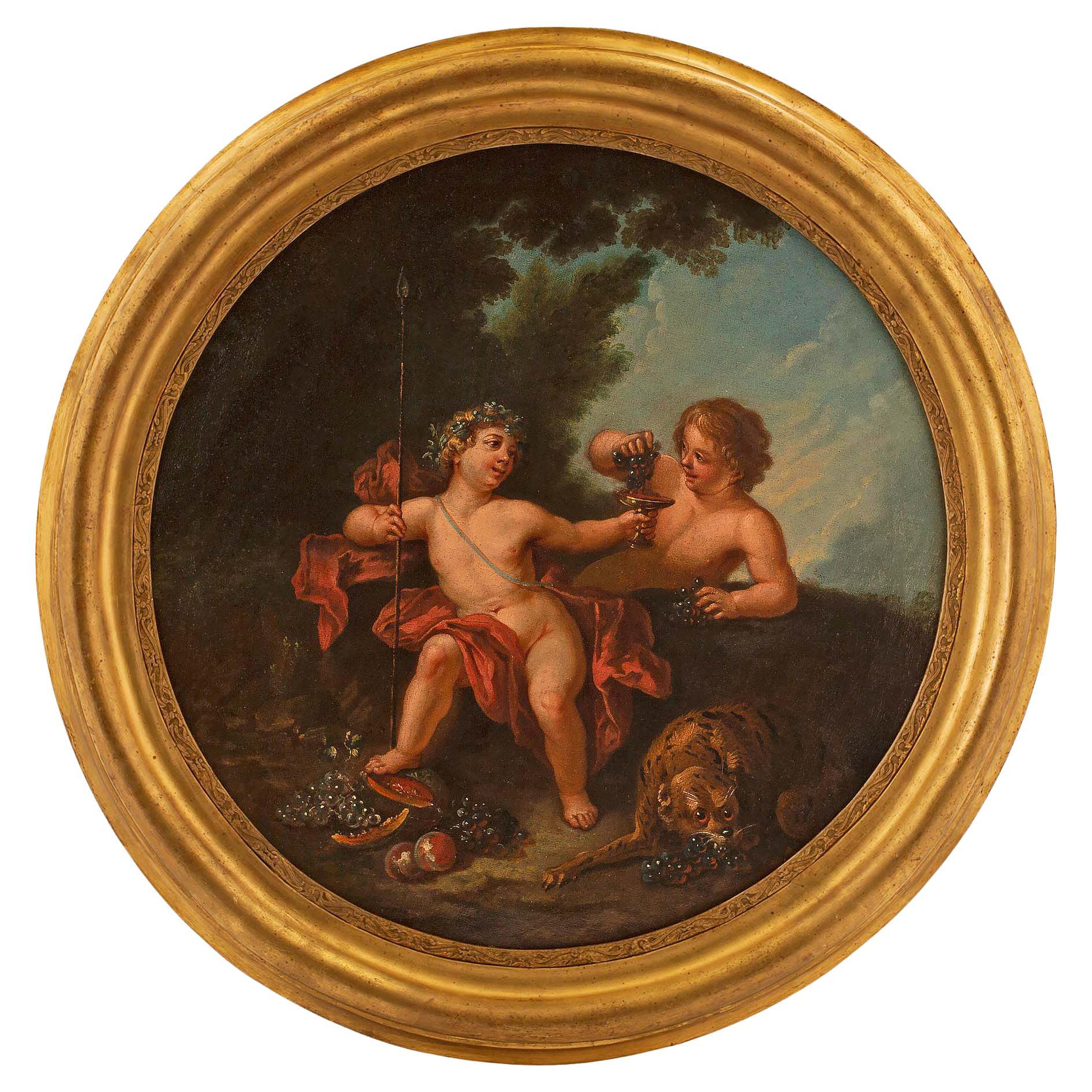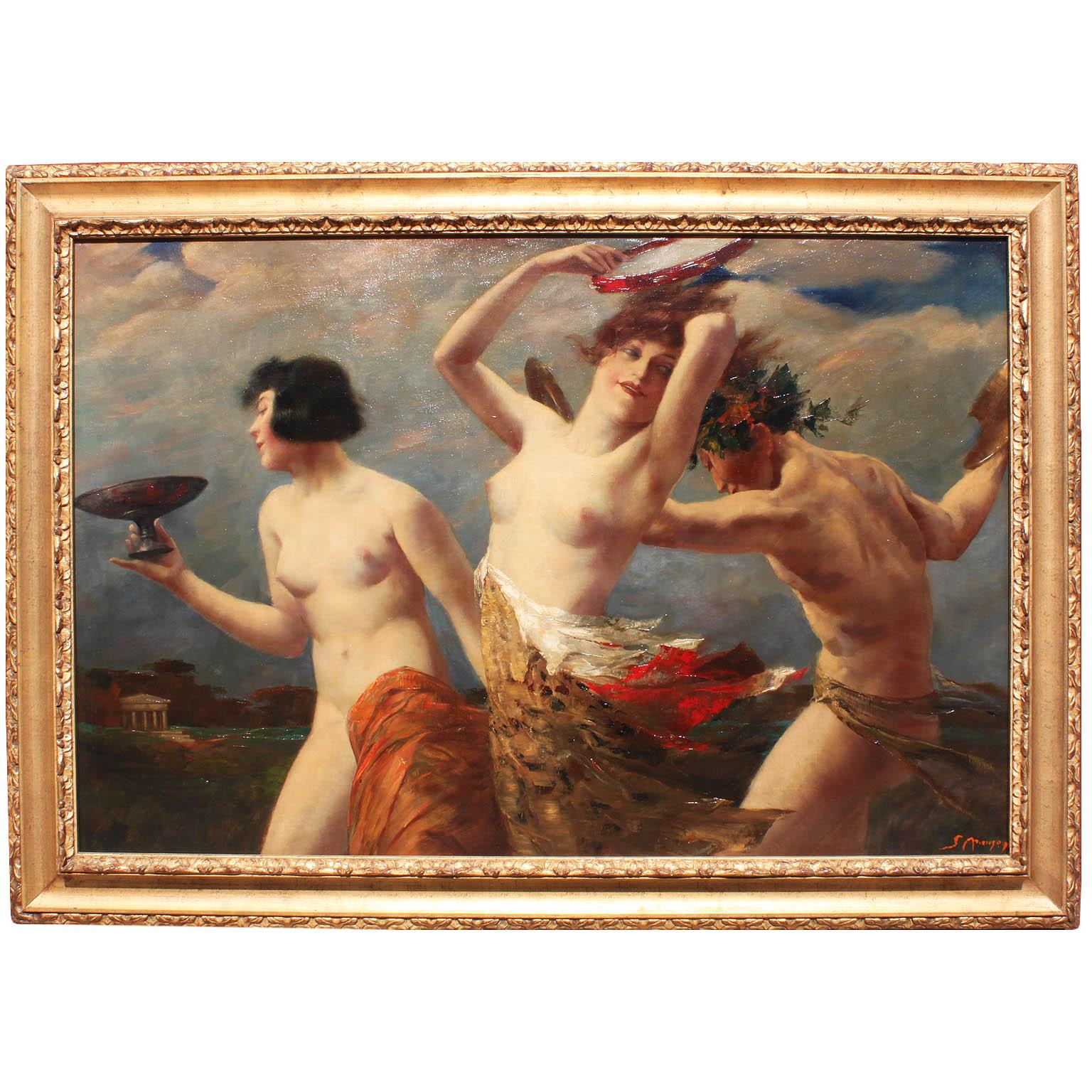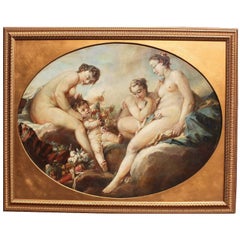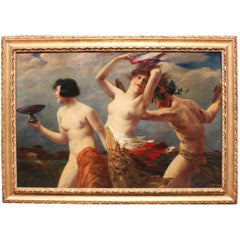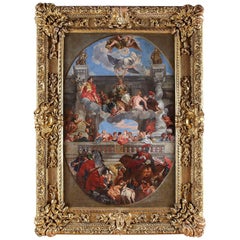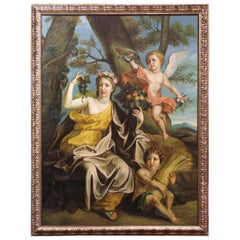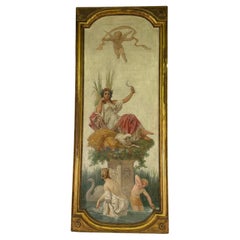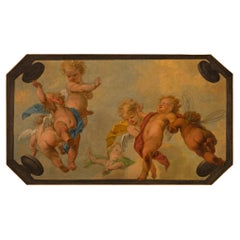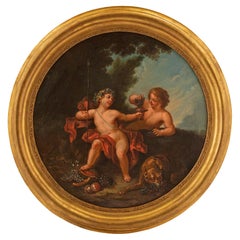Items Similar to Fine 19th Century Oil on Canvas "Triumph of Flora" Attr. Ferdinand Wagner II
Video Loading
Want more images or videos?
Request additional images or videos from the seller
1 of 11
Fine 19th Century Oil on Canvas "Triumph of Flora" Attr. Ferdinand Wagner II
$124,500
£93,674.68
€108,223.93
CA$175,950.99
A$191,048.58
CHF 101,174.20
MX$2,341,708.30
NOK 1,252,070.60
SEK 1,183,140.43
DKK 807,738.94
About the Item
A very fine and large 19th century Louis XV style Whimsical Neoclassical Revival style Oil on Canvas "The Triumph of Flora" attributed to Ferdinand Wagner II (German, 1847-1927), school of François Boucher (French, 1703-1770). The impressive artwork depicting a semi-nude Flora hovering through the clouds surrounded by playful cupids, cherubs, love doves and a seated maiden, within white and grey clouds, offering her Spring flower bouquets and floral wreaths, within a banded giltwood frame. Note: Previously used as a ceiling painting. Unsigned, Circa 1870.
Measures: Canvas height: 91 3/4 inches (233 cm)
Canvas width: 59 inches (150 cm)
Frame height: 61 3/8 inches (155.9 cm)
Frame width: 93 1/2 inches (237.5 cm)
Depth: 2 3/8 inches (6 cm)
Ferdinand Wagner II (German, 1847-1927) was the son of Passau Ferdinand Wagner Senior, a teacher at a vocational art school who began training him professionally at a young age. After traveling to Italy in 1867-1868, he continued with his art studies at The Munich Academy of Arts led by Peter Von Cornelius and Julius Schnorr Von Carolsfeld. Wagner II was influenced by the Munich school of master painters and by his art teacher, Karl von Piloty, who had been teaching at the Munich Art Academy since 1856. Piloty’s approach to historical paintings was influenced by the French art academic Paul Delaroche and by the fine artworks by Rubens and the Venetians.
After his return to Germany he was commissioned to decorate the former the Tenormayer Wine Tavern in Munich, subsequently he received numerous other commissions as a decorator. Ferdinand Wagner II wall paintings and ceiling frescos attracted the attention from the Munich City Hall and he was commissioned to decorate the cellar and at the German Theatre. He also decorated the dining room at The Drachenburg in the Königswinter on the Rhine, the Café of Roth and Luitpold in Munich and The Tivoli Restaurant in London. Between 1890 and 1891 he was comissioned numerous art works for the "Prince Bismarck" Steamboat. In Passau he created works at the town's City Hall. Between 1892 and 1916 he worked continuously decorating the Castle Ratibor by Roth where in 1894 he painted it's main artwork "The Triumph of Aphrodite". Amongst other works, in 1891 he decorated the facade at The Schwyz City Hall, in 1895 the Grand Hall ceiling fresco at the Castle Bueckeburg's, in 1897 the decoration of the large dining hall at the Famous Munich Hofbräuhaus and in 1899 he was commissioned to decorate the tower hall of the newly built Hamburg City Hall. In Passau, Ferdinand Wagner II was awarded numerous honors where, in 1887, he was named an Honorary Citizen, the Ferdinand-Wagner-Straße Street was named after him and the "Ferdinand Wagner Hall" at the Town's City Hall was named after him as well.
François Boucher (French 1703-1770) was a French painter in the Rococo style. Boucher is known for his idyllic and voluptuous paintings on classical themes, decorative allegories, and pastoral scenes. He was perhaps the most celebrated painter and decorative artist of the 18th century. He also painted several portraits of his patroness, Madame de Pompadour.
A native of Paris, Boucher was the son of a minor painter Nicolas Boucher, who gave him his first artistic training. At the age of seventeen, a painting by Boucher was admired by the painter François Lemoyne. Lemoyne later appointed Boucher as his apprentice, but after only three months, he went to work for the engraver Jean-François Cars. In 1720, he won the elite Grand Prix de Rome for painting, but did not take up the consequential opportunity to study in Italy until five years later, due to financial problems at the Académie royale de peinture et de sculpture. On his return from studying in Italy he was admitted to the refounded Académie de peinture et de sculpture on 24 November 1731. His morceau du reception (reception piece) was his Rinaldo and Armida of 1734.
Boucher became a faculty member in 1734 and his career accelerated from this point as he was promoted Professor then Rector of the Academy, becoming head of the Royal Gobelins Manufactory in 1755 and finally Premier Peintre du Roi (First Painter of the King) in 1765.
Boucher died on 30 May 1770 in his native Paris. His name, along with that of his patron Madame de Pompadour, had become synonymous with the French Rococo style, leading the Goncourt brothers to write: "Boucher is one of those men who represent the taste of a century, who express, personify and embody it."
Boucher is famous for saying that nature is "trop verte et mal éclairée" (too green and badly lit). Boucher was associated with the gemstone engraver Jacques Guay, whom he taught to draw. Later Boucher made a series of drawings of works by Guay which Madame de Pompadour then engraved and distributed as a handsomely bound volume to favored courtiers. The neoclassical painter Jacques-Louis David began his painting instruction under Boucher.
Reflecting inspiration gained from such artists as Peter Paul Rubens and Antoine Watteau, Boucher's early works celebrate the idyllic and tranquil portrayal of nature and landscape with great elan. However, his art typically forgoes traditional rural innocence to portray scenes with a definitive style of eroticism as his mythological scenes are passionate and intimately amorous rather than traditionally epic. Marquise de Pompadour (mistress of King Louis XV), whose name became synonymous with Rococo art, was a great admirer of his work.
Boucher's paintings such as The Breakfast (1739), a familial scene, show how he was as a master of the genre scene, where he regularly used his own wife and children as models. These intimate family scenes are contrasting to the licentious style seen in his Odalisque portraits.
The dark-haired version of the Odalisque portraits prompted claims by the art critic Denis Diderot that Boucher was "prostituting his own wife", and the Blonde Odalisque was a portrait that illustrated the extramarital relationships of the King. Boucher gained lasting notoriety through such private commissions for wealthy collectors and, after Diderot expressed his disapproval, his reputation came under increasing critical attack during the last years of his career.
Museums with paintings by François Boucher (French 1703-1770):
The Metropolitan Museum of Art, New York, NY
The J. Paul Getty Museum, Los Angeles, California
The British Museum, London UK
Musée du Louvre, Paris France.
- Attributed to:Ferdinand Wagner II 1 (Artist)
- Dimensions:Height: 93.5 in (237.49 cm)Width: 61.38 in (155.91 cm)Depth: 2.38 in (6.05 cm)
- Style:Neoclassical Revival (In the Style Of)
- Materials and Techniques:
- Place of Origin:
- Period:
- Date of Manufacture:circa 1870
- Condition:Repaired: Areas in in-paint touch ups, old varnish discoloration, craquelure, minor losses and pin-holes. Wear consistent with age and use. Minor losses. Minor fading. Very impressive artwork in its original canvas, craquelure runs throughout, stretcher marks, frame tilt, surface with age dirt, edges partially abraded with a couple of small screw holes at the edges. Old varnish discoloration and wear. Edge holes.
- Seller Location:Los Angeles, CA
- Reference Number:Seller: Ref.: A25171stDibs: LU1796223085022
About the Seller
5.0
Vetted Professional Seller
Every seller passes strict standards for authenticity and reliability
Established in 1982
1stDibs seller since 2016
135 sales on 1stDibs
Typical response time: <1 hour
- ShippingRetrieving quote...Shipping from: Los Angeles, CA
- Return Policy
Authenticity Guarantee
In the unlikely event there’s an issue with an item’s authenticity, contact us within 1 year for a full refund. DetailsMoney-Back Guarantee
If your item is not as described, is damaged in transit, or does not arrive, contact us within 7 days for a full refund. Details24-Hour Cancellation
You have a 24-hour grace period in which to reconsider your purchase, with no questions asked.Vetted Professional Sellers
Our world-class sellers must adhere to strict standards for service and quality, maintaining the integrity of our listings.Price-Match Guarantee
If you find that a seller listed the same item for a lower price elsewhere, we’ll match it.Trusted Global Delivery
Our best-in-class carrier network provides specialized shipping options worldwide, including custom delivery.More From This Seller
View AllFrench 19th Century Oil on Canvas "Venus Disarming Cupid" after François Boucher
By François Boucher
Located in Los Angeles, CA
A large French 19th century oil on canvas laid on board painting in the manner of François Boucher (French, 1703-1770). The oval framed canvas depicting a version of Boucher's "Venus...
Category
Antique Late 19th Century French Romantic Paintings
Materials
Canvas, Wood, Plywood
$8,450 Sale Price
32% Off
19th Century Oil on Canvas Bacchante Group Attributed to Leopold Schmutzler
Located in Los Angeles, CA
A large 19th century oil on canvas Bacchante group depicting two allegorical young semi-nude maidens dancing with pan, attributed to Leopold Schmutzler...
Category
Early 20th Century German Greco Roman Paintings
Materials
Canvas, Giltwood
$12,950 Sale Price
48% Off
18th-19th Century Oil on Canvas "The Triumph of Venice" After Paolo Veronese
By Paolo Veronese
Located in Los Angeles, CA
A very fine and Large Italian 18th-19th century oval-shaped oil on canvas titled "The Triumph of Venice" After the original work by Paolo Veronese (Venice, 1528-1588). The original of this painting hangs in the Palazzo Ducale, Venice. The 'Ricci' coloration suggests a late 17th-early 18th century date. In 1715 Charles de la Fosse advised Ricci to paint only "Veroneses and no more Riccis", Venice, circa 1800.
Measures:
Height: 45 1/4 inches (115 cm).
Width: 29 inches (73.7 cm).
Frame height: 58 1/4 inches (147.9 cm).
Frame width: 43 1/4 inches (109.9 cm).
Frame depth: 5 1/4 (13.3 cm).
Provenance: Royal Academy of Scotland.
Paolo Veronese (Born 1528, Verona, Republic of Venice - died April 9, 1588, Venice) was an Italian painter of the Renaissance in Venice, famous for paintings such as The Wedding at...
Category
Antique Early 1800s Italian Renaissance Paintings
Materials
Wood, Gesso, Canvas
$69,750 Sale Price
44% Off
After Fragonard French 19th Century Oil on Canvas Progress of Love-Lover Crowned
By (After) Jean-Honoré Fragonard
Located in Los Angeles, CA
A large French 19th century oil on canvas (laid down on a masonite) "Les progrès de l'amour dans le cœur d'une jeune fille" The Progress of Love: The Lover Crowned, after Jean-Honoré...
Category
Antique 19th Century French Rococo Paintings
Materials
Masonite, Gesso, Canvas, Giltwood
$18,950 Sale Price
24% Off
German 19th Century Oil on Canvas Triptych of Cherubs by Ferdinand Wagner II
By Ferdinand Wagner II 1
Located in Los Angeles, CA
Ferdinand Wagner II (German, 1847-1927) A very fine and charming triptych group of three oil on canvas laid on board titled "An Allegory to Spring" each panel depicting different playful and joyous scenes of putti and a cherubs reminiscent of spring, love and peace. The center panel depicting a seated putto, crowned with flowers, a standing putto behind him holding a sack of arrows and a seated cherub facing him next to a watchful peace dove on top resting of a flower bouquet. The left panel depicting a seated putto next to a standing putto with a freshly harvested apple. The right side panel depicting a standing cherub holding a fig branches with leaves. All three-in-one panels within individually carved giltwood frames. All panels signed at the lower left: Ferd. Wagner, circa 1890.
Ferdinand Wagner II (German, 1847-1927) was the son of Passau Ferdinand Wagner Senior, a teacher at a vocational art school who began training him professionally at a young age. After traveling to Italy in 1867-1868, he continued with his art studies at The Munich Academy of Arts led by Peter Von Cornelius and Julius Schnorr...
Category
Antique Late 19th Century German Rococo Revival Paintings
Materials
Canvas, Wood
French 19th Century Old Master School Oil on Canvas Titled "Leda and The Swan"
Located in Los Angeles, CA
A fine and large French 19th century old master school oil on canvas titled "Leda and The Swan" within a giltwood frame. Leda and the swan is a motif from Greek mythology, in which Z...
Category
Antique 19th Century French Renaissance Revival Paintings
Materials
Giltwood, Canvas
$49,850 Sale Price
40% Off
You May Also Like
Large Mid-Century French Allegory Oil on Canvas Painting in Carved Frame
Located in Dallas, TX
Painted in France circa 1960, and set in a carved silvered and black frame, the important mythological painting on canvas depicts an allegoric outdoor scene featuring a Roman or Gree...
Category
Mid-20th Century French Paintings
Materials
Canvas, Giltwood
Antique French Allegorical Summer Oil Painting - By Henri Picou
Located in Scottsdale, AZ
C1865 Antique French Allegorical Summer Oil Painting - By Henri Picou
The Neo-Greco woman is holding a scythe in her hand. Beautifully executed.
Unique piece purchased in France. Ag...
Category
Antique 19th Century French Neoclassical Paintings
Materials
Canvas, Giltwood, Paint
Italian 19th Century Neo-Classical Oil On Canvas Ceiling Painting
Located in West Palm Beach, FL
A beautiful wonderfully executed Italian 19th century Neo-Classical oil on canvas ceiling painting. The elongated octagonal shaped painting depicts se...
Category
Antique 19th Century Italian Neoclassical Paintings
Materials
Canvas
Italian 18th Century Neo-Classical Oil on Canvas Painting
Located in West Palm Beach, FL
An extremely charming Italian 18th century Neo-Classical oil on canvas painting. The circular painting retains its original giltwood frame with a beautiful mottled designs and finely...
Category
Antique 18th Century Italian Neoclassical Paintings
Materials
Canvas, Giltwood
Original Oil On Canvas Large Allegorical Painting, Italian School 1750-1800
Located in Round Top, TX
Original large oil on canvas allegorical scene from Italy with vivid colors. Note the Pegasus, ten figures, and use of lute, lyre and flute.
Condition: Age related craquelure throug...
Category
Antique 18th Century Italian Paintings
Materials
Canvas, Wood, Paint
19th Century, Italian Painting with Still Life with Cherubs
Located in IT
19th century Roman painter
Still life with cherubs, flower festoons and herma with faun
Measures: Oil on canvas, cm H 78 x W 95 without frame
Cm H 122.00 x W 106 x D 8 with frame.
The work, painted in oil on canvas, octagonal in shape, represents a nature with three putti or cupids playing with flower festoons in a wooded environment in which is placed a herma with faun and, on the left, a large neoclassical marble vase...
Category
Antique 19th Century Italian Baroque Paintings
Materials
Canvas
More Ways To Browse
Barbizon Giltwood Frame
Billy Seay
Buddha Paintings
Chinese Port Paintings
Danish Painting Ship
Emile Bernard
European Horse Painting
Finnish Modern Painting
Franco Oil Paintings
German Painting On Porcelain
German Portrait Painting 1920
Ghana Movie Poster
H Schouten
H Zatzka
Hank Virgona
Hardy Strid
Harry Boostrom
Jesus Chucho Reyes
